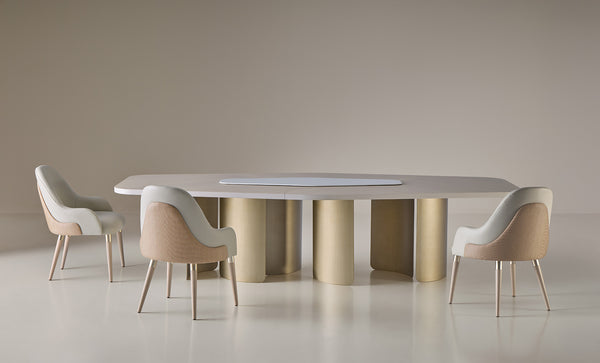How to install textile wallpaper
Applying fabric wallpaper on interior walls is not the same as with classic paper or vinyl wallpaper, because the fabric is less rigid and more prone to glue stains, which are more difficult to remove (if at all).
For this reason, we recommend that you use the services of an experienced professional when applying textile wall coverings. We can recommend qualified professionals for the best results. Dušek Décor is not responsible for unwanted defects caused by incorrect wallpaper application.
PREPARATION
Calculate how many linear meters of fabric you will need. Our fabric wallpapers are wound on 1.3 meter wide rolls and are available in various lengths.
When calculating the required meters, take into account the pattern and direction of the pile of the fabric. Fabrics that have a pile (velvet, jacquard) will always be wound in the direction of the pile. For best results, install the fabric wall covering with the fibers pointing downwards (ie, wiping from top to bottom smooths out the fabric).
Add another 5 cm to the ceiling and floor, which you cut off with a sharp knife along the skirting board after applying the fabric (we recommend buying quality floor and ceiling skirting boards at www.DDlišty.cz ).
- Check everything before cutting.
- Use fabrics with the same batch number for each wall. Lots may vary slightly in color as these are real fabrics.
- Apply the strips in the order of cutting after unrolling the roll.
- The edges of the wallpaper are professionally trimmed and will not fray.
- Take into account where the lighting is already mounted on the wall and choose the side to start with the first strip so that you don't, for example, feed the wallpaper right next to the lighting.
- The importance of a well-prepared foundation cannot be underestimated. A good foundation is essential for a beautiful result.
THE SURFACE SHOULD BE
-
Smooth: any surface irregularities may leave visible marks. The surface must be smoothed and any depressions must be filled and sanded smooth.
-
Dry: New plasters require several days to dry completely.
-
Compact: Gypsum walls or freshly applied stucco must be treated with adhesive penetrating coatings.
-
Clean : old wallpaper and adhesive residues must be removed. The wall must also be dust-free.
-
Uniform color : differences in color on the surface of the underlying wall can sometimes be visible when using a light transparent fabric. Make sure to get rid of color differences by applying a thin layer of light paint.
-
Lightly absorbent: the substrate must be able to absorb a little of the adhesive, but not too much. A surface that absorbs too much adhesive, such as new stucco, may not hold the wallpaper, and in that case, we recommend applying a smoothing agent or diluted adhesive. For proper dilution, follow the instructions on the glue package. Allow the wall to dry for at least 1 day afterwards. Also, a substrate with poor absorption properties would not be able to hold the wallpaper and must be smoothed beforehand or treated with penetration.
APPLICATION
- Use the right tools: a sharp knife and/or sharp scissors, a plastic spatula and a soft brush. We recommend using a roller with hard edges for pressing seams. Make sure there are no pebbles on the spatula that could damage the fabric. Always work with clean tools and with clean hands.
- Never pull loose threads, but cut them with scissors or cut them with a knife.
- Before applying the glue, for wallpapers with pile (velvet, jacquard), think about which direction the pile should go. It should usually point down.
- The adhesive must be applied to the wall and not to the fabric. We recommend using our glue for the best result.
- Do not use too much glue to apply the textile wallpaper so that it does not leak. The glue must be applied evenly.
- Our fabrics are not resistant to glue stains, so work carefully and use only clean tools. If a drop of glue gets on the fabric, clean it immediately with lukewarm water and a microfiber cloth. Never use cleaning products or a washing sponge. Some types of textile coverings (e.g. silk) are practically impossible to clean. When using this type of fabric, place absorbent paper (eg kitchen towels) over the joint to immediately absorb excess adhesive. However, it is better to use the right amount of glue and spread it evenly to avoid excess glue.
- Unless otherwise stated on the label, the strips must be laid edge to edge.
Joints in fabric wallpaper may still be visible in some types of material, even if the above instructions are carefully followed. This is usually caused by the lighting and also the fabric's pile-pattern and cannot be prevented as we are working with real fabrics.
ADHESIVE
We offer three sizes; 2, 5 and 10 liters.
1 liter of glue is enough for approximately 5 m2.
To calculate how much glue you need, we use the following formula: the number of meters of length multiplied by 0.26.
Example : The wall is 5m long and 3m high. The fabric is 130 cm wide. So we will apply 4 vertical stripes next to each other, that is 12 linear meters of textile wallpaper: 12 x 0.26 = 3.12. We will need 3.12 liters of glue.
You can buy the glue
HERE .


